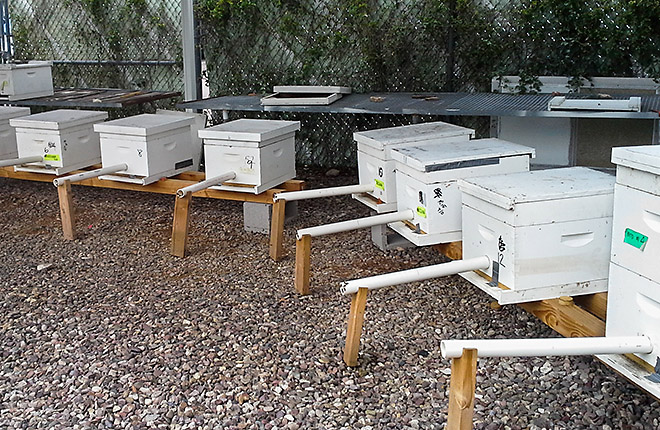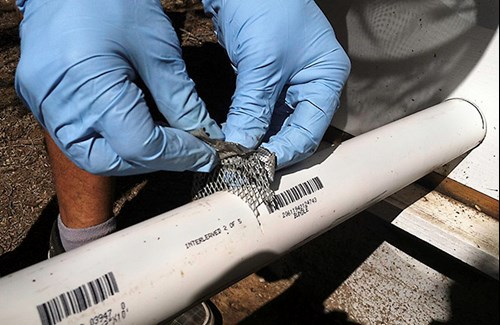Migratory Mites Threaten Bee Hives
Agricultural Research Service (ARS) scientists are tracking a honey bee killer, and their investigations have taken them from hives in Tucson, Arizona, to Bismarck, North Dakota.
Led by ARS entomologist Gloria DeGrandi-Hoffman, the team is staking out hive entrances and monitoring the comings and goings of foraging honey bees, which may be the killer's unwitting accomplices.
Instead of cordoning off the site with crime-scene tape, they've blocked access to each hive using a PVC pipe with a trap door in the middle that separates bees entering and leaving the hive.
|
|
None of the busy little winged bearers of pollen and nectar will get by without inspection: The prime suspect—an eight-legged, pinhead-sized parasite called the Varroa mite—seems to be sneaking into the hives on the bees' bodies.
The Varroa mite, Varroa destructor, is considered public enemy number one to honey bees nationwide. The parasite feeds on the blood of adult bees and their brood, weakening them and endangering the entire hive when infestations become severe. But the mite also poses an indirect threat to more than 90 flowering crops that depend on bee pollination, including almonds, apples, blueberries, cherries, and cantaloupes.
According to DeGrandi-Hoffman, who leads ARS's Carl Hayden Bee Research Center in Tucson, Varroa populations are slow growing because each female mite produces only 2 to 3 offspring during her lifetime. So, if a mite population in a newly established bee colony is low during the spring, it should remain that way for at least a season.
Sometimes, though, Varroa numbers can soar to dangerous levels sooner than that—namely, in the fall and sometimes even after applications of miticides during the summer months. To the researchers, this suggests a factor other than the mites' reproductive rate is contributing to the population increase.
"The mites may attach to foragers when the foragers raid the food stores of weak colonies collapsing from high mite infestations," explains DeGrandi-Hoffman. "Drifting foragers (lost bees) carrying mites also could contribute to the movement of Varroa among colonies."
In the 2015 studies, the team compared actual counts of Varroa in colonies with values from a mathematical model constructed by DeGrandi-Hoffman that predicts growth of Varroa populations based on mite reproduction. The predictions matched actual Varroa population growth rates in the hives up until November. That's when the predictions deviated from actual mite numbers, which jumped fourfold-an increase that couldn't be explained by mite reproduction alone. Instead, the November increase correlated with increased numbers of mite-bearing foragers captured at colony entrances. The team published its findings in the May 2016 issue of Experimental and Applied Acarology.
The researchers' investigations in North Dakota this summer will follow up on their leading theory to explain this phenomenon, dubbed "mite migration." It holds that Varroa mites move among colonies by attaching to forager bees.
In addition to further investigating at the Bismarck site, the researchers are evaluating a potential way to head off mite migration-by placing hives in refrigerated storage from November to January.
"We'll compare the cost of storing colonies as opposed to letting the bees remain active throughout the winter," says DeGrandi-Hoffman. "We'll also measure the return on investment in cold storage versus free-foraging colonies, as determined by colony survival, strength, and rental value for almond pollination." — By Jan Suszkiw, ARS Office of Communications.
Key Facts
- Varroa mites are honey bee parasites.
- Mites move to new bee colonies by attaching to foraging bees.
- ARS scientists are studying ways to control mite migration.
Full Story









